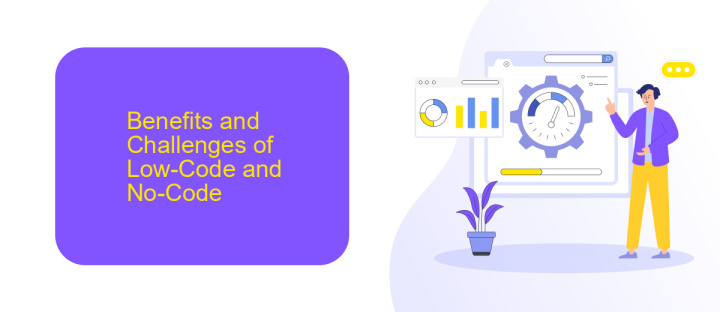Low-Code No-Code Definition
Low-code and no-code platforms are revolutionizing the way businesses develop software by enabling users to create applications with minimal or no coding knowledge. These tools provide intuitive interfaces and pre-built templates, allowing both technical and non-technical users to streamline development processes, reduce costs, and accelerate time-to-market. This article explores the definitions, benefits, and key differences between low-code and no-code solutions.
Definition of Low-Code and No-Code
Low-code and no-code platforms are revolutionizing the way businesses develop applications by simplifying the coding process. These platforms enable users to create software solutions with minimal or no coding knowledge, making technology more accessible to a wider audience.
- Low-Code: Platforms that require some coding knowledge but significantly reduce the amount of manual coding needed.
- No-Code: Platforms that allow users to build applications without any coding knowledge, using visual interfaces and pre-built modules.
These platforms are ideal for accelerating development processes, reducing costs, and empowering non-technical users to innovate. Services like ApiX-Drive enhance these platforms by offering seamless integration solutions, enabling users to connect various applications and automate workflows without extensive coding.
Benefits and Challenges of Low-Code and No-Code

Low-code and no-code platforms offer numerous benefits, including increased development speed and reduced costs. These platforms empower non-technical users to create applications without extensive programming knowledge, democratizing software development and fostering innovation. They also enable faster prototyping and iteration, allowing businesses to respond swiftly to market changes. Additionally, low-code and no-code solutions can enhance collaboration between IT and business teams, ensuring that applications are aligned with business needs and objectives.
However, there are challenges associated with low-code and no-code platforms. One significant concern is the potential for limited customization and scalability, which may not meet the needs of complex projects. Security and compliance issues can also arise, as these platforms might not offer the same level of control as traditional development methods. Integrating with existing systems can be another hurdle, but services like ApiX-Drive can help streamline these integrations, ensuring seamless data flow between applications. Lastly, reliance on a specific platform can lead to vendor lock-in, making it crucial for businesses to carefully evaluate their long-term needs before fully committing.
Examples and Use Cases of Low-Code and No-Code

Low-code and no-code platforms are revolutionizing the way businesses develop applications by significantly reducing the need for extensive coding knowledge. These platforms enable users to create applications through graphical user interfaces and configurations, making the development process more accessible and efficient.
- Business Process Automation: Companies can streamline their operations by automating repetitive tasks. For example, HR departments can use low-code platforms to automate employee onboarding processes.
- Custom CRM Solutions: Sales teams can quickly build customized CRM systems tailored to their specific needs without relying on traditional development cycles.
- Integration of Services: Tools like ApiX-Drive facilitate the integration of various services and applications, allowing businesses to connect different platforms effortlessly.
- Prototyping and MVP Development: Startups can use no-code platforms to rapidly prototype and develop minimum viable products (MVPs) to test market viability before committing to full-scale development.
These examples demonstrate the versatility and efficiency of low-code and no-code platforms. By enabling users to build, automate, and integrate applications quickly, these tools empower businesses to innovate and adapt in a rapidly changing technological landscape.
Trends and Future Development of Low-Code and No-Code

The rise of low-code and no-code platforms is reshaping the landscape of software development, making it more accessible to non-technical users. These platforms enable rapid application development, reducing the time and cost associated with traditional coding methods. This democratization of software development is fostering innovation across various industries.
As businesses continue to adopt digital transformation strategies, the demand for low-code and no-code solutions is expected to grow. These platforms are not only enhancing productivity but also driving collaboration between IT and business teams. The ability to quickly prototype and iterate applications is becoming a crucial competitive advantage.
- Integration with AI and machine learning for smarter applications
- Enhanced security features to protect sensitive data
- Expansion of pre-built templates and modules
- Improved user experience and customization options
- Seamless integration with third-party services like ApiX-Drive
Looking ahead, the future of low-code and no-code platforms is promising. As technology advances, these tools will become even more powerful, enabling users to create complex applications with ease. The continuous improvement in integration capabilities, such as those offered by ApiX-Drive, will further streamline workflows and enhance the overall efficiency of businesses.
- Automate the work of an online store or landing
- Empower through integration
- Don't spend money on programmers and integrators
- Save time by automating routine tasks
Best Practices for Using Low-Code and No-Code
When leveraging low-code and no-code platforms, it's crucial to start with a clear understanding of your business requirements. Define the problem you're trying to solve and ensure that the chosen platform aligns with your goals. This initial step will help in selecting the right tools and setting up a roadmap for development. Additionally, prioritize user feedback during the development process to make necessary adjustments and improvements in real-time.
Another best practice is to focus on integration capabilities. Many low-code and no-code platforms offer built-in connectors for various services, making it easier to integrate with existing systems. For instance, using a service like ApiX-Drive can streamline the process of connecting multiple applications, ensuring seamless data flow and enhancing functionality. Regularly test and validate these integrations to maintain system efficiency and reliability. Finally, provide adequate training for end-users to maximize the platform's potential and ensure smooth adoption across your organization.
FAQ
What is Low-Code/No-Code?
Who can benefit from using Low-Code/No-Code platforms?
What types of applications can be created with Low-Code/No-Code platforms?
Are Low-Code/No-Code platforms secure?
How can Low-Code/No-Code platforms integrate with existing systems?
Do you want to achieve your goals in business, career and life faster and better? Do it with ApiX-Drive – a tool that will remove a significant part of the routine from workflows and free up additional time to achieve your goals. Test the capabilities of Apix-Drive for free – see for yourself the effectiveness of the tool.


